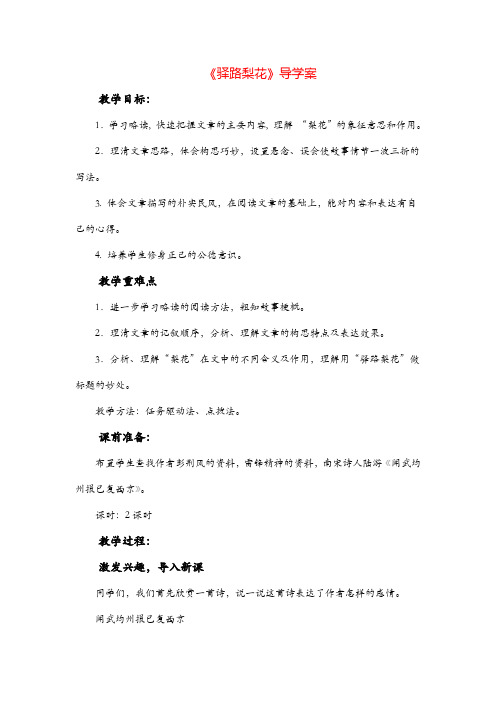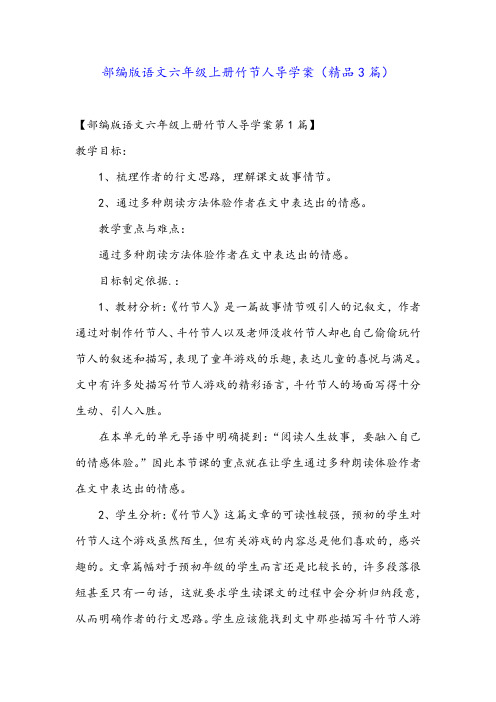记叙文阅读专题导学案1
- 格式:doc
- 大小:52.00 KB
- 文档页数:2

《走一步,再走一步》导学案(精选12篇)《走一步,再走一步》导学案篇1教学目标:1.有创意地阅读课文并复述故事2.学会思索,感悟日常生活中所寓含的深刻哲理3.培育同学乐于尝试,敢于冒险的精神4.培育同学患难与共的爱心5.体悟文中“化整为零,克服困难”的方法,增加自己制服困难的信念教学重点:探究“走一步,再走一步”的含义教学难点: 多角度地思索同一现象,获得不同的感悟和体验(一)同学学习过程设计:1:课前自学:(1)诵读、勾画、点评批注(2)阅读并了解本文相关的背景学问2:课内学习: (1)同学沟通自学内容:字、词的读音、词义;及背景(2)同学独学:同学朗读课文并思索下列问题:a:课文主要记叙了什么事情?这件事情发生在什么时候?什么地方?发生的缘由是什么?b:“我”为什么“一时拿不定办法”?后来又为什么跟着伙伴们去爬山了呢?c:“我”在爬山途中都遇到了哪些困难?当时“我”是怎么想的?d:后来“我”又是怎样脱险的?脱险以后“我”有什么感觉?(二)老师活动设计:1:课前预备:对课文内容进行深化分析,对同学课堂上将要涉及的问题有充分的预备2:课堂导学:(1)老师检查同学自学状况(2)老师引导同学复述课文内容并予以方法的指导(3)老师指导同学再读课文,谈谈自己读了这个故事后有什么感想?(三)同学对学、小组群学并沟通:1:探究性品尝文中“脱险”部分,深化理解文章主旨:(1)找出这部分开头的自然环境描写,想想有什么作用?(2)父亲为什么指挥“我”先迈出左脚的一小步?这对你有什么启示?(3)“你能办得到的”“这好像能办得到”“我能办得到”朗读这三句话时重音放在哪个字上?三句话的语气有什么不同?后两句写出了我的什么变化?(4)我在父亲的指导下仅仅是爬下了几米高的石架,为什么还说“我产生了巨大的成就感”?(5)结合课文最终一段,说说你对题目“走一步,再走一步”的理解。
2:老师让同学沟通学习答案,各小组展现学习效果。

《驿路梨花》导学案教学目标:1.学习略读, 快速把握文章的主要内容, 理解“梨花”的象征意思和作用。
2.理清文章思路,体会构思巧妙,设置悬念、误会使故事情节一波三折的写法。
3. 体会文章描写的朴实民风,在阅读文章的基础上,能对内容和表达有自己的心得。
4. 培养学生修身正己的公德意识。
教学重难点1.进一步学习略读的阅读方法,粗知故事梗概。
2.理清文章的记叙顺序,分析、理解文章的构思特点及表达效果。
3.分析、理解“梨花”在文中的不同含义及作用,理解用“驿路梨花”做标题的妙处。
教学方法:任务驱动法、点拨法。
课前准备:布置学生查找作者彭荆风的资料,雷锋精神的资料,南宋诗人陆游《闻武均州报已复西京》。
课时:2课时教学过程:激发兴趣,导入新课同学们,我们首先欣赏一首诗,说一说这首诗表达了作者怎样的感情。
闻武均州报已复西京南宋陆游白发将军亦壮哉,西京昨夜捷书来。
胡儿敢作千年计,天意宁知一日回。
列圣仁恩深雨露,中兴赦令疾风雷。
悬知寒食朝陵使,驿路梨花处处开。
这首诗最后一句“悬知寒食朝陵使,驿路梨花处处开。
”是说,可以预料到来年寒食节,祭扫宋先帝陵墓的使者,将通过梨花盛开的驿道而到达洛阳。
表达了陆游听到收复西京的消息,异常高兴的心情。
作家彭荆风借用这首诗的诗句“驿路梨花处处开”写了篇散文《驿路梨花》,今天我们学习这篇文章,探究彭荆风要通过“驿路梨花处处开”表达怎样的情感?二、预习检测:1.填写文学常识:《驿路梨花》作者是,他是代作家,作品有《》、《》、《》等。
背景资料:《驿路梨花》写于1977年5月。
当时,我经历了“文革”7年牢狱之灾后,出狱已近两年。
那是5月间的一个下午,我午睡刚醒,慵倦地躺在床上读《宋诗选》,当读到陆游“悬知寒食朝陵使,驿路梨花处处开”的诗句时,那美丽的意境使我联想起了过去在滇西南边地大山深处见过的大片梨花林,以及与梨花有关的许多特异人事,那都是我长久难以忘怀的美好生活。
这时候,一种想用文笔描述那和谐过去的创作愿望也油然而生,我忙披衣起床抓过纸笔来写作。

雕饰凤头迈出亮丽第一步——记叙文开头写作指导朱刘中学周素春学习目标:1、理解开头的作用。
2、掌握写记叙文开头的几种方法,并能在一定程度上灵活运用。
课前延伸案欣赏以下几篇文章的开头:1、《“惜”》对于这个“惜”字,指的是珍惜,它有许多种解释和不同的理解。
我认为“惜”指珍惜一切有价值、有意义的东西,或者是人生中极其重要的东西。
当然有的人说惜应是珍惜时间,有的人说应是珍惜自己眼前的一切,但也有的说应该是珍惜来之不易的机会……但我个人认为,在这段时期我应该珍惜自己有限的青春。
2、《我又想起了过去》过去如行云流水般,当我一转眼时过去又带着我们回到了现在,而现在又将会成为过去,未来也将成为现在和过去。
过去一去不复返,让人深为惋惜,过去又让人回味无穷,那是因为过去曾经给我们带来无比的快乐……3、《发考卷的时候》语文考试后不久,一天上课,老师手里托着一叠厚厚的试卷走进了教室。
这时,全班同学一下子挺直了腰,用发亮的眼睛盯着老师手中的试卷,那神情实在是急不可待了。
白色的试卷伴着哗啦哗啦动人的声响,象波浪一样一起一伏地向后传去。
前面拿到试卷的同学,有的眉飞色舞,斜过身子和别人小声说着;有的愁眉不展,回过头对着别人的卷子。
教室里像开了锅似的顿时热闹起来。
课内探究案一、写好记叙文开头要求1、要适应主题的要求,与下文衔接自然,意思连贯,而不要说废话,兜圈子。
2、要新颖,要能吸引读者,但也不要刻意追求新奇,故弄玄虚。
3、要言简意赅,凝炼明快。
二、写好记叙文开头常用的方法:1、开门见山法即在文章的第一段开篇点题,或点明题目,或点及中心,使文章不拖泥带水,不转弯抹角,而是简洁明快、单刀直入。
例如:(1)我与父亲不相见已二年多了,我最不能忘记的是他的背影。
《背影》(2)我的好朋友郑小川,矮矮的个子,圆圆的脸,那双水灵灵的大眼睛,闪烁着机灵的光芒。
《我的好朋友》(3)时间匆匆,总不会为任何事物停下脚步。
蓦然回首,那日子就像在雪地里留下的脚印,有的深,有的浅…(《珍藏的记忆》)2、巧设悬念法这种开头方法给读者留下了悬念和想象空间。

人教版九年级英语《记叙文阅读与指导》学习任务单及作业设计第一课时【学习目标】1.阅读文本A Mother’s Day Card.2.通过文本中的语言,动作,神情分析人物。
3.通过人物情感态度的变化分析文本主题。
【学习准备】准备好学案阅读文本资源、笔和笔记本,做记录。
【学习方式和环节】听课学习,按老师指令完成相应的课上练习。
学习环节主要有:(1)认真聆听老师关于学习目标及记叙文的解读。
(2)阅读 A Mother’s Day Card,完成表格及问题。
(3)根据老师的讲解核对并修订自己的答案。
(4)完成课后作业。
【学习资源】A Mother’s Day Card“I wouldn’t buy that woman a Mother ’s Day card,if my life depended upon it,”said the woman standing in the greeting card aisle at Wal-Mart.I looked up and saw a look of total disgust and disappointment.Having been dropped off at a Florida orphanage at age four, I never knew what it felt like to have a mother or a father. Never once had I received a hug or a kiss from my parents. That portion of my life is a total blank.She looked up, saw me looking at her and screamed, “Just what are you looking at, idiot?”“Sorry Ma’am. I never had a mother and I was taken aback by your words.”“If you want the worthless woman, you can have her,”she replied.I reached over and picked up a nice-looking card, opened it and began to read, “Thank you just for being my mother.”“Do you think your mother would like that card? Mine would, I think,”I said.“Do you know what it is like to be yelled at for years and never be told that you are loved?”she asked.“My mother didn’t care enough about me to yell. She just took me to the orphanage and that’s where I stayed until I grew up.”I replied.“Don’t you hate her?”she asked.“Oh, I can’t hate her. She’s my mother. Being a mother is a position to be respected, even if your mother is not a very nice person.”I told her.The woman stood there shaking her head.Then she looked me straight in the eye and stared as hard as she could.I looked down at the floor and said, “I know your mother might have done a lot of things that you dislike. It appears you almost hate the woman. But I can tell you this from experience, that disliking her, or even hating her, feels nowhere near as lonely as never having known a mother at all —good or bad. At least you feel something. I feel nothing! It’s all just a large blank of loneliness inside my heart, and that’s how I’ll feel until I die.”The woman stood there for several seconds. Slowly, she reached out, and took the card from my hand, smelled it and placed it in her cart.After she left I picked out a nice card for my mother. I took it home, signed it and I placed it with the other Mother and Father ’s Days cards I have bought throughout the years.Their address is the same as mine. They live in the f ile cabinet inside a folder marked “UNKNOWN.”【作业设计】Passage OneAfter a lazy Christmas holiday, I had to recover from climbing stairs with carry-on bags and a suitcase. I looked up—Red tape crossed the door. I didn’t understand French, but the one English word said enough, "POLICE." Google Translate told me I would be caught if I entered, so I didn't.Finally, I called my rental agent (收租人).He went to the police station for more details. The thief had taken a few items from the top drawer as well as a small amount of money in the bo ttom drawer. Not only were my files undisturbed, but so were the TV and printer. My agent also said something about fixing the locks tomorrow and making a list for the police.Then one day, I remembered that I had left another jewelry box in the flat. My heart sank as I thought of a gold locket (项链坠) with a picture of my late Grandma inside. When I realized the box was missing, the whole experience seemed to crash down on me. I cried. At the end of January, I received a letter from the police. The thief hadn't been found, and the case was closed. I slept with my purse by my bed. I hid my laptop when I showered. And then another challenge came —I was unexpectedly fired by my company.One July night, I reached into my third drawer to pull out my jean shorts. I heard something fall to the ground. I looked down: It was the tiny jewelry box I thought had been stolen s ix months earlier. Inside was the locket with honey Grandma smiling at me, being there for me, telling me not to give up. I started to cry. I kne w that things were going to be OK.1. What did the red tape across the writer's door mean?A. The police had arrested the thief.B. The house couldn't be entered freely.C. The house was for sale.D. The writer didn't pay the rent on time.2. What did the agent promise to do?A. To fix the locks the next day.B. To report the thief to the police.C. To pay for the missing things for the writer.D. To help the writer rent another flat.3. Why did the writer cry again at last?A. She cried over her bad luck.B. She recalled the smiling of her grandma.C. She regained her confidence.D. She recovered the stolen jewelry box.Passage TwoThe Sixth Time I Went to the Principal’s OfficeWhen I was in the seventh grade, I had problems behaving. My heart was in the right place, but I couldn’t always follow the rules. I played many tricks on my schoolmates. Once, I even pulled a girl’s hair on the school bus to get her attention. As a result, I was repeatedly sent to the office of th e principal(校长). Although I hated going there, I did not hate the principal, Mr. Ratcliff.Mr. Ratcliff was a kind, elderly man. When he spanked(打屁股) me for putting some ants into a classmate’s pencil box, it didn’t hurt at all, but it did hurt my feelings. I thought so much of him and moments like that seemed to prove I was hopelessly bad.When I got called to Mr. Ratcliff ’s office for the sixth time, I had no idea what I had done. I felt disappointed as I walked down there. I went into his office, sat down, and looked at the floor. Then he said the last thing I expected to hear:”Kevin, I’ve heard you’ve been behaving really well lately. I want you to know how proud I am of you, and I just called you down to my office to give you a peppermint.”“Really?”I was surprised.“Yes. Now you can take that peppermint and go back to class.”I carried the peppermint with me as if it was a gold coin. When I got into my classroom, I bragged(吹嘘)to my classmates about my turnaround, excitedly. I wasn’t so bad after all.Mr. Ratcliff was really kind. He made me realize that I was just a kid who had problems with behavior.Hebought some peppermints and took the time to notice me when I got something -anything-right. Mr.Ratcliff gave me some hope by giving me some love. I will just remember him for the rest of my life.1. In his seventh grade, the writer __________.A. hated the principalB. had problems behavingC. always followed the rulesD. often helped his classmates2. How did the writer feel when he went to the principal’s office for the sixth time?A. Lonely.B. Excited.C. Confident.D. Disappointed.3. The sixth time the writer went to the principal’s office, he got __________.A. a peppermintB. a model busC. a pencil boxD. a coin4. The writer will always remember Mr. Ratcliff, because the principal __________.A. talked with him in the officeB. played games with himC. expected him to be a teacherD. gave him some hope and love【参考答案】Passage One:BACPassage Two:BDAD第二课时【学习目标】在新的材料情境中迁移运用记叙文的阅读方法。

部编版语文六年级上册竹节人导学案(精品3篇)【部编版语文六年级上册竹节人导学案第1篇】教学目标:1、梳理作者的行文思路,理解课文故事情节。
2、通过多种朗读方法体验作者在文中表达出的情感。
教学重点与难点:通过多种朗读方法体验作者在文中表达出的情感。
目标制定依据.:1、教材分析:《竹节人》是一篇故事情节吸引人的记叙文,作者通过对制作竹节人、斗竹节人以及老师没收竹节人却也自己偷偷玩竹节人的叙述和描写,表现了童年游戏的乐趣,表达儿童的喜悦与满足。
文中有许多处描写竹节人游戏的精彩语言,斗竹节人的场面写得十分生动、引人入胜。
在本单元的单元导语中明确提到:“阅读人生故事,要融入自己的情感体验。
”因此本节课的重点就在让学生通过多种朗读体验作者在文中表达出的情感。
2、学生分析:《竹节人》这篇文章的可读性较强,预初的学生对竹节人这个游戏虽然陌生,但有关游戏的内容总是他们喜欢的,感兴趣的。
文章篇幅对于预初年级的学生而言还是比较长的,许多段落很短甚至只有一句话,这就要求学生读课文的过程中会分析归纳段意,从而明确作者的行文思路。
学生应该能找到文中那些描写斗竹节人游戏的精彩语句,但情感体验不够深入。
六年级的学生喜欢朗读,但朗读方法还是比较欠缺的,这节课,我试图引导学生通过多种朗读方法去体验作者在文中表达的情感。
教学过程:开放式导入:你有过动手制作玩具的经验吗想一想你从中获得了什么与同学们分享一下。
1、环节1:初读课文,熟悉内容。
(1)默读课文,熟悉内容。
(2)填写表格,梳理文章事件及情感脉络。
(3)小组交流,完善表格。
(4)全班交流。
(设计意图:任务驱动,整体感知课文,梳理作者的行文思路。
) 小结:通过这个环节的学习,我们知道了像读这样篇幅比较长的记叙类文章,通过表格的方式梳理文章的层次、事件和人物的情感脉络会比较清晰的理出作者的行文思路,帮助我们理解课文主要内容。
2、环节2:细读课文,品味语言(1)请个别学生朗读8—19节。

《中考复习专题--欲扬先抑》导学案学习目标:掌握记叙文中欲扬先抑的作用。
一、回顾教材,考点探源1.回归教材,参考课本中“预习提示”“批注”及课后“思考探究”梳理下表。
2.通过对教材内容的梳理,我们发现提问的方式可能有:二、以文析法,归纳策略。
1.阅读《阿长与<山海经>》第2-21段,回答问题。
文章重点写阿长为“我”买来《山海经》,为什么前面要花那么多笔墨写和阿长有关的其他事情,请简要分析。
结论:2.阅读《藤野先生》第6-23段,回答问题。
选文⑨⑩段能否删掉?请说明理由。
结论:3.阅读《白杨礼赞》后三段,回答问题。
选段运用了欲扬先抑的手法,请说说它的表达效果。
结论:三、以法析文,巩固策略。
1.试分析《列夫·托尔斯泰》中欲扬先抑手法的作用。
2.阅读《荔枝蜜》,回答问题。
①花鸟草虫,凡是上得画的,那原物往往也叫人喜爱。
蜜蜂是画家的爱物,我却总不大喜欢。
说起来可笑。
孩子时候,有一回上树掐海棠花,不想叫蜜蜂蜇了一下,痛得我差点儿跌下来。
大人告诉我说:蜜蜂轻易不蜇人,准是误以为你要伤害它,才蜇;一蜇,它自己耗尽生命,也活不久了。
我听了,觉得那蜜蜂可怜,原谅它了。
可是从此以后,每逢看见蜜蜂,感情上疙疙瘩瘩的,总不怎么舒服。
②今年四月,我到广东从化温泉小住了几天。
四围是山,怀里抱着一潭春水,那又浓又翠的景色,简直是一幅青绿山水画。
刚去的当晚,是个阴天,偶尔倚着楼窗一望,奇怪啊,怎么楼前凭空涌起那么多黑黝黝的小山,一重一重的,起伏不断?记得楼前是一片比较平坦的园林,不是山。
这到底是什么幻景呢?赶到天明一看,忍不住笑了。
原来是满野的荔枝树,一棵连一棵,每棵的叶子都密得不透缝,黑夜看去,可不就像小山似的!③荔枝也许是世上最鲜最美的水果。
苏东坡写过这样的诗句:“日啖荔枝三百颗,不辞长作岭南人”,可见荔枝的妙处。
偏偏我来的不是时候,满树刚开着浅黄色的小花,并不出众。
新发的嫩叶,颜色淡红,比花倒还中看些。